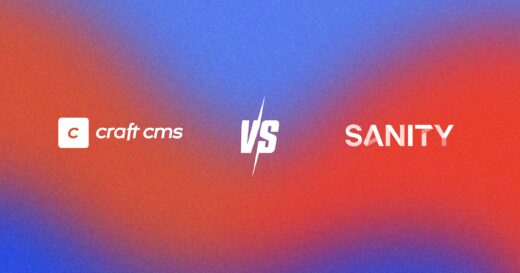The benefits of using Craft CMS
8 min read

We decline to work with potential new clients every year because they’re resolved to stick with WordPress.
It might be the most popular CMS out there, but being big and widely known doesn’t mean it's the best—and it’s not.
We put all of our eggs in one basket six or seven years ago — we can’t remember when exactly — swiftly falling in love with Craft CMS and all that its content management system had to offer. We used WordPress previously, and it’s become a studio-wide red flag: the ex we’ve blocked and avoided in public.
We dated Craft CMS — on and off — then we took the plunge to make it official, and it's been a monumental success for our clients and us as a business since. It’s our specialism as a digital agency, and we love it.
What is Craft CMS, and is it any good?
As a Craft verified partner, some might call us biased, but we’ve had the experience of using other CMS platforms to know a good thing when we see (use) it. Craft positions itself as a flexible, user-friendly CMS for creating custom digital experiences on the web—everything you’ll need, nothing you won’t. That’s one of the key selling points for our clients and us.
User experience
Customer-side
One of the best things about designing and developing for Craft is its flexibility. We only have to consider Google’s recent core updates to understand that websites need to be more user-friendly, more accessible and more considered in 2022 and beyond. That means templates are starkly outdated and aren’t designed for a business’s audience and the user experience they expect.
In our recent experience working with brands such as Ella’s Kitchen and Taylor Maxwell, it’s evident that businesses are more focused on tailoring experiences for their audiences and associated personas—every audience has different needs and goals, and working with out-of-the-box templates is like shoe-horning a size 9 into a 5; painful.
Craft allows designers and clients to work together to create bespoke customer journeys that translate across design flow and call-to-action strategies. Why is that good for the customer? It makes it easy for them to find content and achieve their goals online, promoting loyalty, customer retention and good brand perception.
Client-side
When it comes to content management systems, there’s an expectation for them to be usable. WordPress has always been lacking in that regard. Craft, however, has a user interface that’s practical, logical and simple to use. It empowers developers to build intuitive backends and form relationships between content, making it effortless for content managers to create internal links, quickly build new pages and easily manage marketing elements such as SEO. That means it’s possible to implement campaigns effortlessly and keep user journeys slick with easy 301 redirects and live preview pages before they even get a taste of going live.
We’ve introduced clients such as Ella’s Kitchen, Taylor Maxwell, The Real Debt Guy, Zing, Fletchergate Industries, HES, Autism East Midlands — take a breath — to Craft, and absolutely every single one of them loves it and how empowering it is for them to use.
And how do we know customers love Craft websites? Like hips, analytics don’t lie—we see improvements in acquisition, session duration, bounce rates and conversion with every website that’s moved to Craft from another CMS. Of course, that’s not just down to the CMS; the planning is behind that, too, and our talented team of designers and developers.
Website performance
Optimisation
Like Waitrose, websites have essentials, too, and optimisation is one of them. The problem with templates — yes, we have a bee in our bonnet — they’re not all updated regularly and quickly become outdated. For a lot of businesses, they’ll end up needing to hire a developer to make structural changes for optimisation if issues are identified in the first place. Some companies blame their marketing team, channels, content, etc., for a lack of leads and enquiries—ever considered it’s the actual build of the website and its poor performance?
Some templates look good and have elegant micro animations that can make a website more interactive and polished, but often, beauty is only skin deep, and the ugly truth is just beneath the surface. We’re talking about bloated, broken code, unnecessary javascript, no image optimisation, no heading structure, slow load speeds, and so on. Have you ever wondered why there is often such a disparity between some agencies across cost and time? The fact is that the lower the price and the less time it takes, the less tailored a website will be to your audience and your needs and futureproofing its optimisation and design.
Occasionally, clients will ask us to perform an SEO audit—our customers just aren’t finding us online! And whilst SEO has a huge role in that (organically), a big reason for it is often because of how the website has been built. Not to mention that Google now indexes and ranks websites differently based on desktop and mobile and penalises bad user experience. Every time, it’s been a WordPress or Shopify template that’s had poor performance.
The great thing about Craft CMS is that Craft developers can build the code from scratch. That might sound costly and time-consuming, but it makes for clean, considered code that incorporates all the technicalities required to host a hardworking, fast, optimised and rankable website.
Content management
We’ve written an article on why content managers love Craft and why Craft is a forward-thinking tool for marketers, but let’s talk about why Craft is so effortless for us — I’m a content manager, too — to continually update our website with ease.
I love Craft because I can create pages for the content I need in minutes, knowing the websites I manage have been built and designed for the audiences I’m addressing and for SEO, too. It’s quick to build pages out of components, and I can link entries seamlessly. There are SEO tabs for me to add in meta information, and I can see SEO previews and page previews before I’ve even made the page live (and I can share it with stakeholders before that too).
Knowing what components are available to me and how they work means I understand how the content I create will work on the page. It’s frustrating after writing to find that it doesn’t work on a page how you imagined, but that’s the beauty of Craft and its flexibility; the planning, the design, and the development mean that every page is considered for both the user and the content managers.
Craft community
Craft has one problem: many people haven’t heard of it. In some respects, it’s a best-kept secret. An Ace of Spades waiting to be played, but it can put a lot of businesses off—it's small, what if it goes under, what if they don’t make updates, what’s the security like, do they even have plugins?
Sure, in the grand scheme of things, Craft is ‘green’, but global brands such as Netflix, Adidas, Ikea, SONOS, Wrangler, and MOZ use it as their trusted CMS. It has a worldwide partner network, is used by the world’s top agencies and has been awarded Best WordPress Alternative.
It’s 100% customisable, which means you don’t have to fit your business into a template; it’s designed and built for your business and audiences (we know we keep beating this drum, but it’s so important), and what’s more, yes, it has a store for plugins, and there are loads of them. We’ve narrowed down our favourites for Craft CMS and Commerce.
The Craft community are knowledgeable, friendly, and always readily sharing their expertise. From a Discord group to a yearlyDot All Conference and local meetups like ours in Nottingham, it’s a thriving community that grows year on year.
There’s plenty to break down to get to the nitty gritty of Craft, such as one-off license payments, easy image transformation, Craft’s Matrix builder, Sprout reports, SEOmatic, Blitz and Twig, which is all very interesting (more so for the developers). In terms of what Craft does for businesses, it empowers them—it gives control and improves the experience, efficiency and analytics. It provides a hard-working website to drive traffic, conversion and brand loyalty.
Whilst Craft may not be the most well-known CMS (yet), it’s certainly making its mark in the industry and one we will continue to advocate for.
If you’re reading this because you’re considering moving to Craft from WordPress (this is your sign to do so) or from another CMS or Commerce, get in touch for a chat, and we can talk more about how Craft can help improve your business and authoring experience.
If you’re reading this as a developer, especially one based in the UK, hey 👋 We’re looking for a web developer to join our team; fancy getting hands-on with Craft at Abstrakt?
Craft CMS vs Sanity
4 min read

Client Spotlight with Jonathan Eate
4 min read

Dot All Conference 2025
4 min read

